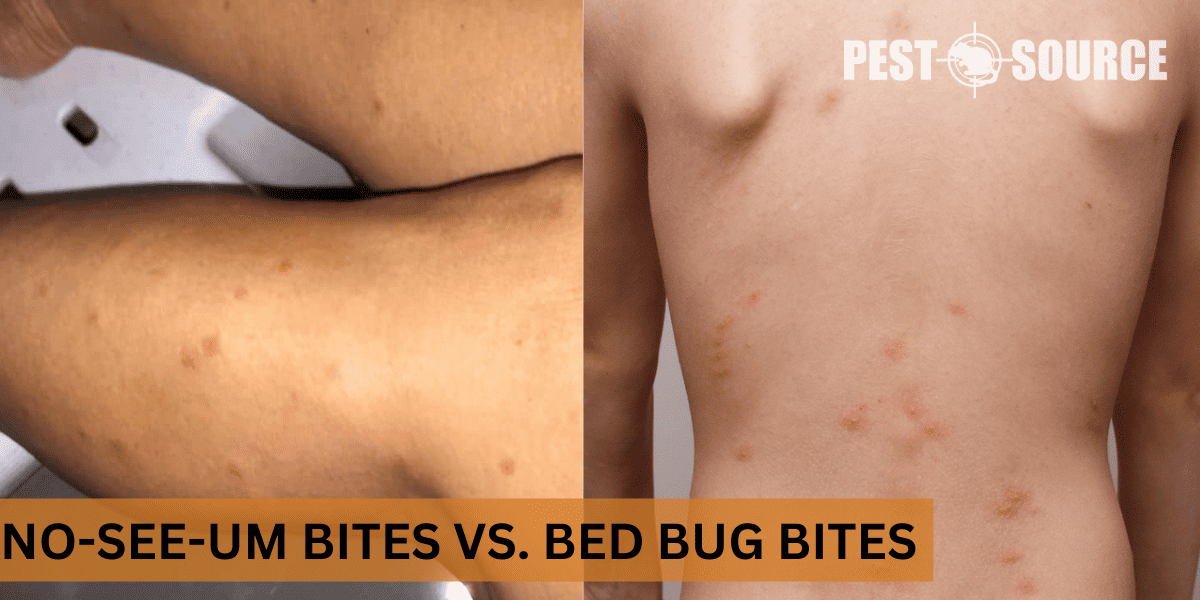When it comes to bug bites, knowing your enemy is half the battle. The similar appearance of no-see-um and bed bug bites can often complicate the identification process, yet the treatment and prevention methods for each are distinct.
This article aims to guide you through understanding the primary differences between no-see-um bites and bed bug bites, helping you with identification, control, and prevention. We will delve into the characteristic behaviors and symptoms of each, discuss effective measures to take, and finally, advise on when to consult professional help. This practical guide serves to make you well-equipped to manage these uninvited guests. Knowledge is your best bug-repellent!
POINTS
- No-see-ums and bed bugs are different types of pests that cause itchy bites. The former primarily lives outdoors and bites through thin clothing, while the latter is an indoor pest that crawls under clothes to reach skin.
- No-see-um bites appear as red, swollen welts, usually in clusters, and are particularly itchy. They are common in warm, moist environments and are attracted to the byproducts of mammalian life.
- Bed bug bites are red bumps, often in a line or zigzag pattern, and can cause intense itchiness. They are commonly found in sleeping areas, attracted by the warmth and carbon dioxide emitted by humans.
- When unsure about the type of bite, it’s best to consult with a medical professional for proper identification and treatment. If an infestation is suspected, reaching out to a professional pest control service is recommended.
- Preventive measures include wearing long-sleeved clothing and using bug sprays for no-see-ums, and regular inspection of bedding and furniture for bed bugs. Check for signs of these pests after travel, to prevent bringing them home. If necessary, professional pest control services can provide comprehensive solutions for both pests.
What Are the Main Differences Between No-See-Um Bites and Bed Bug Bites?
What are no-see-ums and bed bugs?
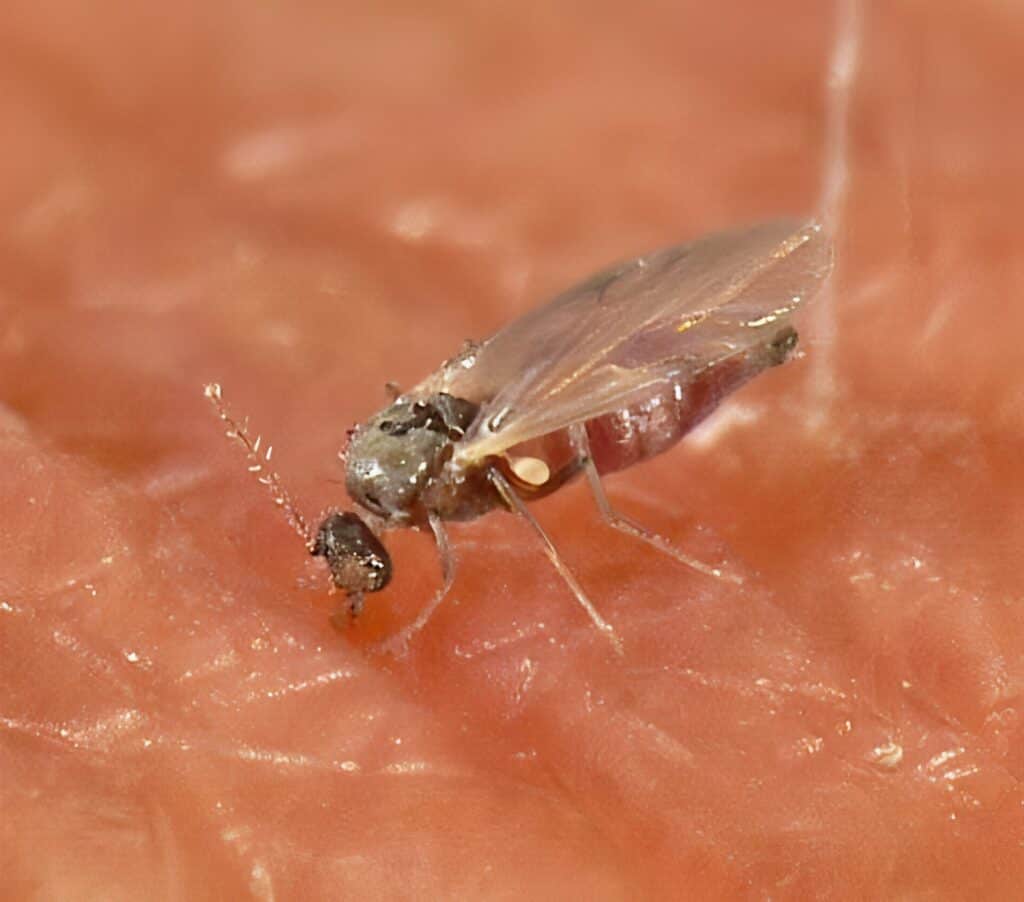
No-see-ums, scientifically known as Ceratopogonidae, are a family of small midges notorious for their bites. They are also known as biting midges, sandflies, or punkies. The adult no-see-ums are so tiny they’re almost invisible to the naked eye.
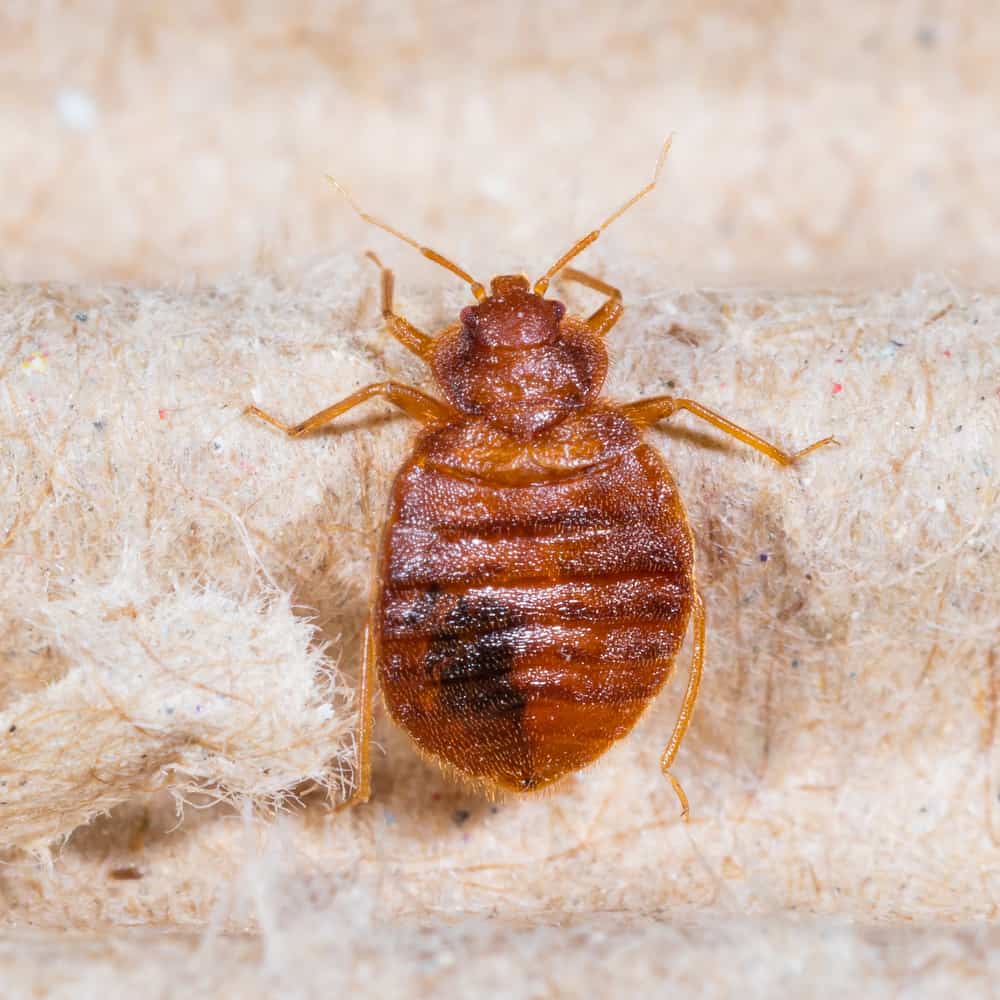
On the other hand, bed bugs, or Cimex lectularius, are small, oval, wingless insects that obtain nourishment from the blood of humans. While they don’t fly, they can move swiftly over floors, walls, and ceilings.
What is the importance of recognizing differences between no-see-um bites and bed bug bites?
Recognizing the differences between no-see-um bites and bed bug bites is critical as the approach to handle each pest is diverse, and incorrect identification can lead to ineffective control measures. Additionally, no-see-ums are typically outdoor pests while bed bugs are indoor pests, having a firm grasp on which is which aids in locating their likely habitats and eliminating them.
What are the typical behaviors of no-see-ums and bed bugs in different climates, such as Arizona and Florida?
In various environments, these pests behave differently. For instance, in the humid environment of Florida, no-see-ums are particularly active during dawn or dusk, when the wind is calm, and temperatures are cool. Conversely, bed bugs thrive in indoor environments with warm temperatures and can infest homes in any state, regardless of the external climatic conditions.
In the drier climate of Arizona, bed bugs thrive just as well in indoor environments. No-see-ums, however, are less common due to the state’s arid conditions, though certain species adapted to deserts can occur, especially near bodies of water. In addition, some species of no-see-ums can be active throughout the day, not just at dawn or dusk.
What Are the Key Characteristics of No-See-Um Bites?
What does a no-see-um bite look like?
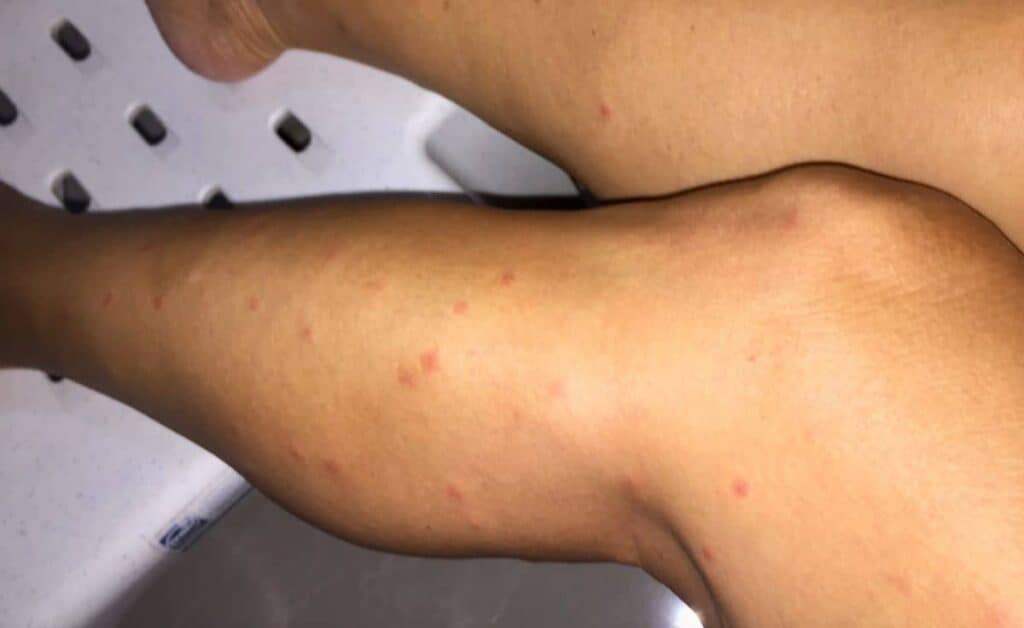
A no-see-um bite typically appears as a small, red, itchy welt. The distinctive characteristic being redness and swelling, about the size of a pinhead. It’s also common to see multiple bites placed close together as they often attack in swarms.
What are the symptoms of no-see-um bites?
When a no-see-um bites, it’s often painless. However, pronounced itchiness generally sets in after a few hours, accompanied by an intense, localized burning sensation. Symptoms worsen over the next few days with the bites forming welts and potentially, blisters.
How do no-see-um bites develop over time?
No-see-um bites usually reach their peak of irritation and size within one to two days of the bite. The swelling and itchiness may persist for a week or more. For individuals with sensitivity to no-see-um bites, these symptoms could last even longer.
In what environments are no-see-um bites most common?
No-see-ums are most prevalent in warm, moist environments, such as marshes, beaches, and lakes during the hotter months. They tend to increase their biting activity during dawn and dusk. Hence, people living near such environments or engaging in outdoor activities around these times are at the most risk.
What attracts no-see-ums to their hosts?
No-see-ums are attracted to carbon dioxide and lactic acid, byproducts of any mammal’s existence, making humans prime targets. Furthermore, they’re also drawn to warmth, motion, dark clothing, and even certain types of food.
Now let’s shift focus to the ever-dreaded bed bugs.
What Are the Key Characteristics of Bed Bug Bites?
What does a bed bug bite look like?
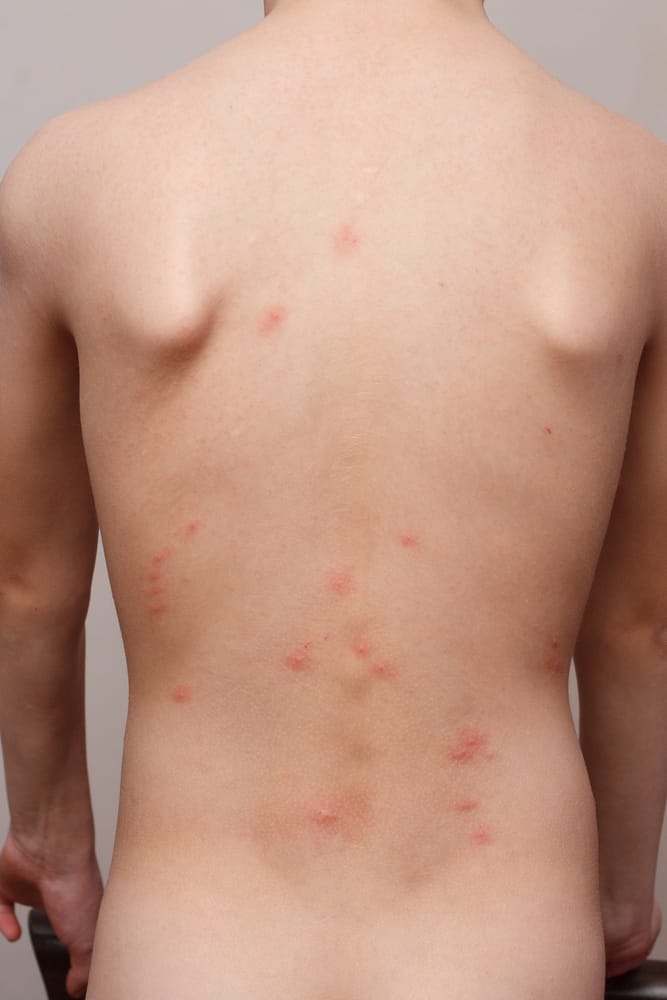
Bed bug bites may look like small, flat or raised bumps on the skin, often inflamed and red. They tend to appear in a zigzag pattern or a line, indicative of the bed bug’s habitual feeding pattern.
What are the symptoms of bed bug bites?
Symptoms can appear immediately or after several days and include itching, reddened skin, or even hives. However, some people might not experience a reaction to the bites at all.
How do bed bug bites develop over time?
Bed bug bites often become increasingly itchy and irritating over days, and in some cases, weeks. Itchiness tends to worsen at night, potentially disrupting sleep patterns. Severe cases might even develop into blisters or hives.
In what environments are bed bugs most common?
Bed bugs mainly infest human habitation, targeting areas where people sleep or rest. These tend to be bedrooms, hotels, dorm rooms, or any location with high human traffic.
What attracts bed bugs to their hosts?
Bed bugs are attracted to the heat and carbon dioxide released by humans. These nocturnal critters usually feed at night when their hosts are asleep, using the cover of darkness to their advantage. They’ll find their way to their prey with an uncanny ability to detect their warmth and carbon dioxide.
How to Distinguish Between No-See-Um Bites and Bed Bug Bites?
How do the appearance and patterns of no-see-um bites and bed bug bites differ?
While both bites appear as red, itchy welts, there’s a distinct difference in their presentation. Bed bug bites usually appear in straight lines or zigzag patterns. No-see-um bites, on the other hand, tend to be clustered and more random in their pattern.
How do location, itchiness, and reaction time vary between no-see-um bites and bed bug bites?
Typically, no-see-um bites are felt on exposed skin areas and become itchy within a few hours of being bitten. With bed bugs, you may notice bites on covered areas as they can crawl under clothing, sheets, and blankets to reach your skin. Bed bug bites might immediately become itchy or take a few days for symptoms to appear.
How long do no-see-um bites and bed bug bites symptoms last?
The duration of symptoms from no-see-um bites and bed bug bites largely depends on the individual’s immune response. Generally, symptoms from no-see-um bites last for a few days up to a week. In contrast, symptoms of bed bug bites can persist for up to two weeks, sometimes longer, due to their more potent saliva which can cause prolonged irritation and itchiness.
How long do no-see-um bites and bed bug bites take time to heal?
The healing time of no-see-um bites and bed bug bites can vary, based on an individual’s immune response and how well they resist scratching the bites. In the case of no-see-um bites, if individuals manage to keep themselves from scratching the itchy welts, their skin typically heals within a week or so. With proper care, the skin should fully heal a few days after the symptoms subside.
On the other hand, bed bug bites could take one to two weeks to heal since the bites can cause allergenic reactions and severe itching, which can sometimes lead to secondary skin infections if scratched. With appropriate treatment and care to avoid infection, the skin usually returns to normal within a couple of weeks. However, in some severe cases, it may take several weeks to completely heal.
How can clothing impact the ability of no-see-ums and bed bugs to bite?
Clothing can offer some level of protection against these pests. No-see-ums can bite through thin clothing, whereas bed bugs cannot, but they can crawl under clothes to reach the skin.
What are the particular characteristics of no-see-um bites in places like Arizona and Florida?
Climate heavily influences the behavior and prevalence of no-see-ums. In humid environments, like Florida, no-see-um bites are more common, particularly around dawn or dusk. In Arizona’s dry climate, no-see-um bites are less common, but still a risk near bodies of water.
Can No-See-Ums Live Indoors or Specifically in Beds?
What are the conditions for no-see-ums living indoors?
Given their preference for a warm, humid environment, no-see-ums can potentially infest indoors if such conditions are met, especially if there’s standing water nearby.
Are no-see-ums found in beds?
While it’s unusual for no-see-ums to be found in beds, they can accidentally be brought indoors. Their tiny size allows them to pass through window screens or doors, and they can end up in your bed if attracted by carbon dioxide emissions when you sleep.
Can no-see-ums live in your bed?
Taking into account their preference for humid, warm environments and the necessity of water for breeding, the chances of no-see-ums establishing residence in your bed are unlikely. However, it doesn’t rule out the possibility of an occasional encounter.
Don’t confuse this with bed bugs; while no-see-ums prefer the outdoors, bed bugs are primarily indoor pests, and they love beds. Hence, their name!
How Do No-See-Um Bites Compare to Other Insect Bites?
How do no-see-um bites differ from flea bites and mosquito bites?
While all three of these bites are similar in that they cause redness, itchiness, and swelling, there are some key differences.
No-see-um bites are always red, swollen, and intensely itchy. Flea bites often have a red halo around a central bite mark, and the itchiness can also be intense. However, the classic symptom of flea bites is that they usually are found around the ankles.
Mosquito bites are likely the most familiar. They usually cause less swelling compared to no-see-um bites, present as a red bump, and the itching, though bothersome, is less intense in comparison.
How do Bed Bug bites differ from sand flea bites and mosquito bites?
Bed bug bites usually appear as a row of red bumps with a darker red spot in the center, often in a line or cluster, and tend to be extremely itchy.
Sand flea bites, however, are typically focused around the feet (since sand fleas jump up from the ground). These bites might be accompanied by a halo and black center point where the insect bit you.
Mosquito bites, as we’ve discussed earlier, are individually less intense than bed bug bites. The red, itchy bump usually appears soon after you’re bitten.
How to Deal with No-See-Ums and Bed Bugs?
What are the common discussions on platforms like Reddit about bed bug and no-see-um bites?
Community platforms like Reddit often come alive with discussions offering peer-reviewed solutions, advice, and shared experiences. Many discuss the most effective over-the-counter treatments, along with home remedies for alleviating the itching. Pest control advice, such as vacuuming and using particular chemicals in a controlled manner, is also readily available.
What are the available products or remedies for no-see-um bites and bed bug bites?
For both no-see-um bites and bed bug bites, over-the-counter remedies include antihistamines and topical corticosteroids to alleviate itching and inflammation. Bed bug infestations are less straightforward to treat and usually require professional pest control to completely eradicate them. For mild cases, certain pesticides and foggers can be used at home.
What are no-see-um killers?
Various insecticides, traps, and foggers that work overall for insects can also be helpful for no-see-um control. DIY repellents using natural ingredients like eucalyptus or tea tree oil can also repel no-see-ums.
What are some common methods to control or kill no-see-ums?
Controlling or eliminating no-see-ums from your home can involve insecticides, trapping, fogging, or the use of professional pest control services. DIY repellents using natural essential oils can also repel no-see-ums.
What are the methods of preventing no-see-um and bed bug bites?
Preventive measures can include wearing long-sleeved clothing and using bug sprays when outdoors for no-see-ums. For bed bugs, regularly check your bedding and furniture and consider using mattress encasements. In addition, regular inspection for bed bugs during your travels, especially in hotel rooms or public places, can prevent bringing them home.
What are home remedies or suggestions from Reddit users for dealing with bed bug bites?
Suggestions often include applying a paste of baking soda and water for relief from itching, using calamine lotion, or even simple ice packs.
Are there any specific measures for specific areas, such as no-see-ums in Arizona and Florida?
In areas with specific pest issues like states of Florida and Arizona, dealing with no-see-ums can be approached by:
- Installing Fine Mesh Screens: As they are tiny insects, regular window screens may not be able to keep no-see-ums out. So, it’s recommended to install fine mesh screens on your windows and doors.
- Using Suitable Repellents: Before heading outside, especially during peak biting times-dawn and dusk, apply insect repellent on exposed skin and clothing.
- Creating a Dry Environment: No-see-ums love moisture, making sure your property is free from standing water can reduce their numbers.
- Using Bug Zappers: Bug zappers can be particularly effective in outdoor areas, attracting and killing no-see-ums along with other bothersome insects. However, they should be positioned at a distance from the area you want to protect, as the light can attract more insects closer to your space. Make sure to empty and clean the zapper regularly to keep it effective.
- Professional Pest Control Services: In severe infestation cases, consider hiring professional pest control services for comprehensive treatment options.
Remember, no-see-ums in Arizona might not be as common as in other states due to its arid climate. However, they are known to breed near bodies of water. So, if you live near a pond, lake, or have a swimming pool, these measures can be particularly helpful.
How can substances like rubbing alcohol be used against bed bugs?
Though rubbing alcohol can kill individual bed bugs on contact, it’s not a reliable method for eliminating an infestation. It’s important to note, repeated use of rubbing alcohol in a closed space can also be a fire hazard.
Who to Consult About No-See-Um and Bed Bug Bites?
What measures should be taken if unsure whether bitten by a no-see-um or a bed bug?
If you’re unsure about the type of bites you’re dealing with, it’s wise to consult with a medical professional. They can typically identify the bite source and prescribe treatment to alleviate the symptoms. Ensuring you don’t scratch the bites, maintaining the cleanliness of the bite, and using over-the-counter creams can help prevent infection.
How can professional pest control methods be utilized for both no-see-ums and bed bugs?
If bites persist or you suspect an infestation of either pest, reaching out to a professional pest control service may be your next best step.
These professionals can accurately identify the pest responsible, assess the severity of the infestation, and provide a comprehensive solution tailored to your specific circumstance. For bed bugs, this usually involves a thorough inspection followed by heat treatment or pesticide application.
For outdoor pests like no-see-ums, pest control services can provide yard treatments, suitable insecticides, or recommendations for environmental modifications to make your property less attractive to these biting midges.
Conclusion
Although no-see-um and bed bug bites may appear similar, understanding their distinctions can influence your steps towards treatment and prevention.
Stay informed, stay protected, and remember, the best course of action when dealing with bites or an infestation is to consult with professionals and use trusted, safe methods. Don’t let these tiny critters bug you anymore!

